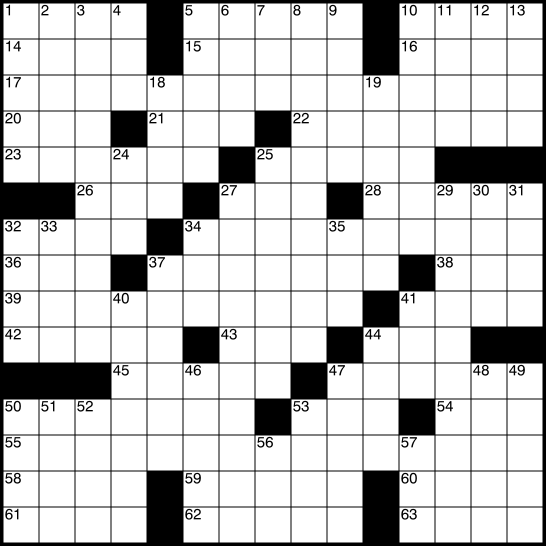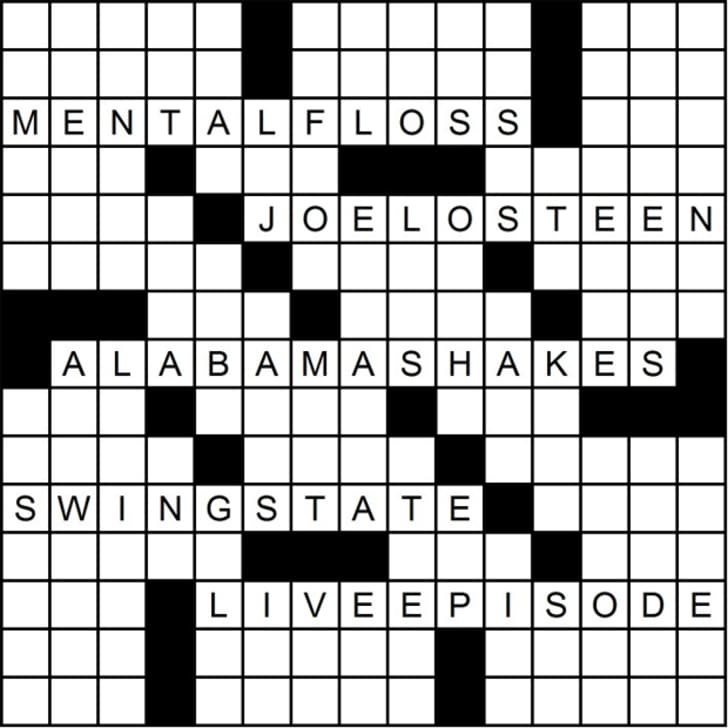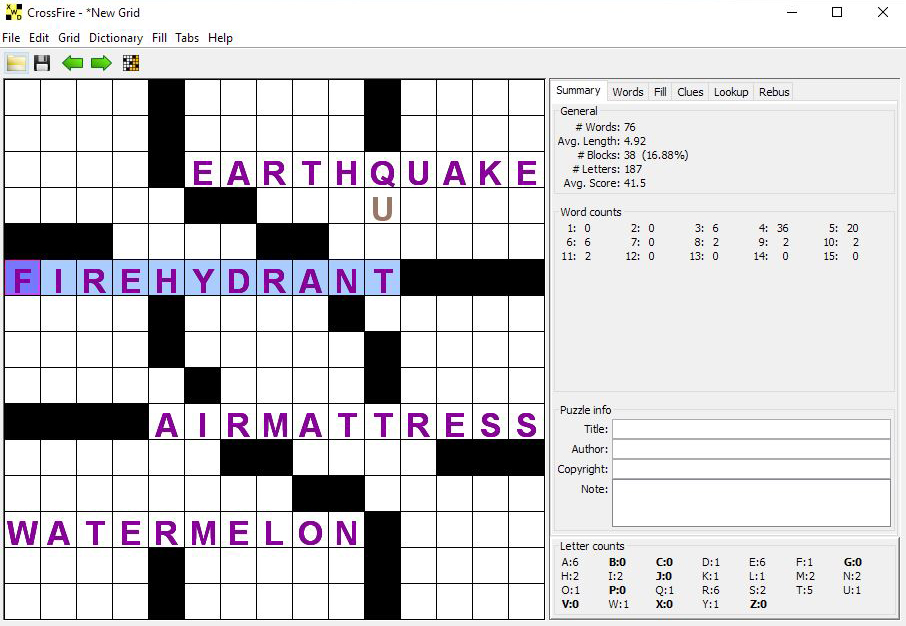Approaches | Rules | Process | References
Approaches
- Crosswords' basic appeal? “My theory is that it's because of...
- Blank: new empty grid; place theme entries; add blocks (dark squares) as needed
-- approach recommended by NYT, Berry; or if you're creating a distinctive pattern. - Choose: an existing grid pattern from a library, usually based on theme entry lengths
- crosserville.com > Grid Search free account; shows # of 3 letter (and other length) words;
File > Export Puzzle > Across Lite text format(most compatible) in order to import grid into another tool - Crossword Compiler app $
- cruciverb.com $
- xwordinfo.com: Most common Shortz-Era & all-time grid patterns;
Grids with the fewest blocks and most blocks;
Most wide open grids; Answers that float outside the grid;
Connect the dots on grids; Record stacks and some notable 15s
Grids with unchecked squares; Oddly shaped or sized grids;
Unusual symmetry and asymmetry; Grid art; 'Interesting' visual elements;
Grids with no short answers or with very short answers, etc. - OnlineCrosswords.net 12 x 12 - 23 x 23
- ugleh.com > Grid Search enter a grid pattern, search for existing variations currently NYT-only
-

American-style grid by Michael J.
via Wikimedia Commons
Attribution-Share Alike 3.0 UnportedModify (for both Blank and Choose) : after entering theme entries, add/move blocks for esthetics, fill, etc.
- From a distance, many typical grids have subareas segmented by:
- "fingers" from edges, i.e., columns and/or rows of several blocks,
and parallel diagonal "steps" [on right] - Perhaps create grid patterns with embedded shapes
e.g., "Utah": 5 black squares that are shaped like the state.
If you put an 11-letter answer at the center of a 15x15 grid,
you will probably need a Utah at either end. e.g., NYT 3/27/2015 - Welcome to Utahs Newsday; 2/18/2022
- Several tools allow you to flip or transpose a grid, i.e., rotate 90° so that Across entries go Down and vice versa:
Crosserville:Grid > Flip Grid
PuzzleMe:Edit grid & clues > Grid > Transpose grid
Rules
- There are a number of conventions and constraints to consider -- first 3 started in the 1920s:
- Fully-crossed: e.g., each (checked) letter appears in both an Across and Down clue.
- Blocks: ~1/6 of total squares; 15 x 15: max 38; themeless: fewer; Sunday: ~74 (55-84)?
- Grid symmetry: e.g., rotational 180° symmetry (a tool can easily preserve).
- Word length: minimum 3 letters -- no unchecked squares or 2-letter words (a tool can notify).
- 3-letter entries: 15 x 15: < ~20
- Rarely, uncrossed squares or 2-letter words might be permitted, depending on theme & editor's flexibility.
- Word count: 15 x 15: max 78; themeless: max 72.
- Grid layout: e.g., connectivity -- 'all-over interlock'; no islands; exception: quadrupuzzle?
- Avoid narrow (1-2 square wide) 'isthmus' -- fewer crossings makes solving much more challenging.
- There can be exceptions, e.g., Fri, NYT 9/8/2022: "Tetris" discussion
- Grid sizes are odd (15 x 15, 21 x 21) by convention
-- plus maintaining symmetry with the 4 center squares may be more difficult in an even-sized grid? - First theme entry usually appears in third row of a 15 x 15 -- or 4th row if 12-14 letters long.
- Same-length theme entries are placed symmetrically Across, usually;
maybe place entries in Down columns if compatible with the theme, e.g., Fall Into Adventure - Additional shorter theme entries in other direction are possible, but less common due to crossing challenges;
in general, I try to minimize the number of multiple theme crossings by any entries to have more fill options later. - 'Cheater' squares, esp. in corners, are discouraged by editors -- why not make those entries longer?
- Theme entries typically abut left or right puzzle edge.
- Optional: unmatched (odd-length) theme or reveal entry centered in middle row;
usually reveal appears last. - Check Crossword Publication Specs for guidance, e.g.
- NYT: "Crosswords must have black square symmetry,
which typically comes in the form of 180-degree rotational symmetry;
Crosswords must have all-over interlock;
Crosswords must not have unchecked squares
(i.e., all letters must be found in both Across and Down answers);
All answers must be at least 3 letters long;
Black squares should be used in moderation.
Maximum Word Count: 78 words for a 15×15 (72 for a themeless); 140 for a 21×21.
Maximums may be exceeded slightly at the editor’s discretion, if the theme warrants" - LAT: "Max word count is 78; under 43 black squares preferred.
All answer words must interlock throughout the grid, and the grid pattern must be symmetrical.
Rotational symmetry, where the grid looks the same upside down as it does right side up,
is preferred, but right/left symmetry is also acceptable if the theme requires it.
A grid with no symmetry or unusual symmetry will only be considered if the pattern is theme-related" - WSJ: "The word count shouldn’t exceed 78 for a 15-by-15 puzzle
and 140 for a 21-by-21 puzzle (though as many as 144 may be allowed in special cases)" - Univ.: "The maximum word count is 80 for a themed 15x15, 74 for a themeless 15x15, and 146 for a 21x21.
There is no maximum black square count -- just be sure to avoid big chunks of black squares (e.g., a 3x3 block)" - Puzzle stats may be useful:
- crosserville.com > Puzzle Stats
# words, # blocks, avg. word len or # 3 letter words; for sizes: 15 x 15 or 21 x 21;
for publisher: NYT, LAT, WSJ, Univ.; for day of week - xwordinfo.com
many free stats available, e.g., Puzzles with the longest avg. word length;
Words and Letters: Shortz Era & All Time; Grids with the fewest words and most words;
Pangrams and puzzles with the fewest letters used;
Rebus puzzles (symbols or multiple letters in a single square);
Schrödinger puzzles aka quantum crosswords - Cruciverb: Advice on Making 21 x 21 Puzzles
maximum word counts differ depending on the editor. From tough to tougher:
Stan Newman: 146; Mel Rosen: 142; Will Shortz: 140; other: 144
Process
- With theme entries placed, prioritize potential problem areas with few fill and crossing word options.
- Avoid letter patterns with no (or very few) possibilities; pay special attention to words containing J, Q, X, Z
- Use quick / auto fill in construction app -- any complete fill possible, even with some obscure words/crosswordese?
- Re-locate blocks and maybe swap theme entries to improve word choice options and eliminate bottlenecks.
- Modify entry lengths by changing noun and verb endings.
- Flip grid horizontally to shift where crossings occur -- or start over with a different grid.
- Repeat as desired, then proceed to Fill (next section)

References / Examples
- NYT: How to Make a Crossword Puzzle, Part 2: Designing the Grid; Building the framework for a puzzle:
Choosing the Right Tool; Placing the Theme Entries; Those Pesky Letters; Fashioning a Fillable Puzzle; The Perils of AutoFill - Heatmaps of NYTimes crossword grids
by day in terms of which patterns are the most common. You can place black squares
and the heatmaps will automatically update to just reflect the crosswords that
also have black squares where you placed them - Crossword Constructor's Handbook (Berry) Chapter 2: Designing the Grid:
Reviewing the Rules; Making a Grid to Match Your Theme; Placing the theme entries;
What's so special about Across entries? Okay, so what's so great about the third row?
Making the grid "fillable"; Take advantage of the maximum word count; The allure of low word counts;
Avoid creating large white areas; Check answer slots that cross your theme entries;
Examine published grids; Avoid using "cheaters"; Using unusual theme placements;
Putting some theme entries among the Downs; Splitting a theme entry across two slots;
Using left/right grid symmetry; Designing Themeless Grids -

from: mentalfloss.com The Art of Crossword Construction (Johnston): Grid Pattern Conventions:
Grid features; Grid symmetries; Things to avoid in grids; Quiz about unacceptable grids - How Crossword Puzzles Are Really Made Gaffney; MF; 9/10/2014
- How to construct a crossword puzzle for the New York Times
Alex Boisvert, Crossword Nexus; video: 9:44; grid: @4:50; 4/23/2013; - WordPlay documentary: Merl creates grid manually: @0:16:12, @0:19:19
-

from: beekeeperlabs.com (CrossFire) - Examples: OLLI (next subsection)
- CROSSWORDS and YOU: Authoring, Refs: Grids
- Comparison of 75022 published crossword grids
- How USA Today is changing crossword symmetry 11/20/2021
- Hidden Word Puzzles: To Circle or Not to Circle?
earlier reveal for easier puzzles? 7/13/2021
